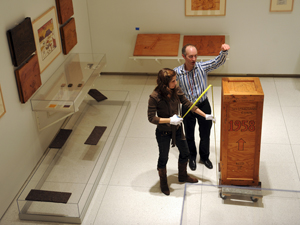Artist’s niche carved
By Rose Schapiro, ’09
Photography by Dan Dry
At first glance, the sculpture that opens the Smart Museum exhibition Your Pal, Cliff seems to be just a small, suited brass man. The 1979 figure was created by the postwar American printmaker and sculptor H. C. “Cliff” Westermann, and originally presented as a gift to his wife, Joanna Beall Westermann. But with this sculpture, as with much of Westermann’s creative output, says Rachel Furnari, AM’02, a doctoral candidate in art history and the exhibit’s cocurator, looking a little closer reveals a lot.
Displayed next to the figure is Westermann’s letter to a friend, diagramming how the thin arms move to tip his metal bowler hat. Westermann wrote beside the drawing, in large, slanted print, “You have to visualize this figure 10” high + made out of 3/8” thick brass. I broke about a dozen jewelers blades cutting it out.” The painstakingly crafted figure, Furnari points out, was also carved with an affectionate inscription on its back. This message refers to Joanna as a “desert flower,” one of Cliff’s many pet names for her. Such relationships, Furnari says, form the centerpiece of the show. Many “love objects” that Westermann made for Joanna and his friends dot the gallery, each crafted with characteristic affection and concern.
 Rachel Furnari and Michael Tymkiw, cocurators of the Smart Museum exhibition Your Pal, Cliff, discovered surprises about the artist H. C. Westermann.
Rachel Furnari and Michael Tymkiw, cocurators of the Smart Museum exhibition Your Pal, Cliff, discovered surprises about the artist H. C. Westermann.Westermann’s art moved in a different direction than the broad conceptual abstraction that dominated postwar America. Vivid prints on the exhibit’s wall show intricate, wood-block scenes of deserts, UFOs, war. Despite his bright, graphic style—Westermann studied commercial graphics at the School of the Art Institute of Chicago on the GI Bill before re-enlisting to fight in Korea—much of his art features dark motifs like death-skulls and burning ships.
On an April Thursday, the exhibit’s public opening is a few hours away, and Furnari wanders through the gallery sections, each of which represents a motif in Westermann’s work. She and cocurator Michael Tymkiw, MBA’02, AM’06, also a doctoral candidate in art history, began sifting through the H. C. Westermann Study Collection last summer to plan the exhibit. The majority of the collection was a 2002 gift to the Smart from the estate of Westermann’s widow and has since been supplemented by donations from friends, including art critic Dennis Adrian, AB’57, who suggested the Smart Museum as a permanent host for the collection.
The study collection consists of materials from Westermann’s daily life and artistic practice—hundreds of letters he received from artists, his art dealer, and family; the woodblocks he used to make prints; the tools and equipment from his studio. “He was also a very good acrobat,” Furnari says. “He made his own acrobatic rings and balancing blocks.” All of these items are stored at the Smart, which will dedicate a portion of its contemporary space to a rotating selection from the collection after the exhibit closes September 6.
The archive of correspondence and ephemera shows Westermann’s “understanding of himself in relationship to society after the war,” Furnari says, noting that he has so far been regarded as a gifted craftsman with few ties to the art world of his era. “He didn’t talk to a lot of people about his work,” she says. “There are definitely moments of surprise about ways he’s been understood until now.”
Tymkiw, in Berlin on a Fulbright fellowship, writes in an e-mail, “Our overall approach was to let the material shape the exhibition.” They read every letter, looked over every object—top, bottom, and sometimes inside. Furnari says: “We started going through archival materials. We were sifting, trying to make connections.” Tymkiw adds, “For every one shown, there were probably two that we couldn’t bring out.”
“We had way too much stuff,” concurs Furnari. “We could so easily have filled this space again.” Some items, like the tools, were left out of the exhibit. “We tried to represent them obliquely,” she says. Viewers don’t have to look hard to understand that Westermann knew his tools intimately. In addition to flawless, polished carpentry, his work has clever details—he even carved lettering on the cases he made to hold his sculptures, some of which are shown at the Smart with the materials still inside. With the same impeccable carpentry technique he used for his art, Westermann built his own crates to ship works to museums, imploring staff members, “Keep this crate!” One of them, reconstructed, sits in the gallery.
What most interested the curators, Tymkiw explains, were the “overlaps and ruptures” between Westermann’s public and private life. “It really creates a sense that he was not so much of an outsider,” says Furnari, citing the whimsical, often bawdy letters Westermann exchanged with artists more entrenched in the art world, like Jeff Koons and Ed Ruscha. “He was aware of what was going on.”
Return to top